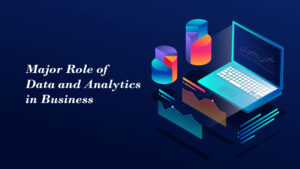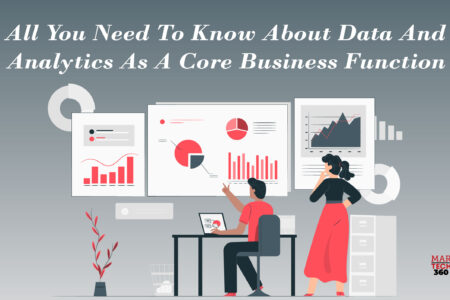In today’s rapidly evolving world, data and analytics, often referred to as D&A, have emerged as the driving force behind informed decision-making, innovation, and competitive advantage. This dynamic duo empowers businesses, industries, and individuals with the insights needed to navigate the complex landscape of our data-driven society.
Let’s explore the world of D&A along with its major role in every type of business.
What is Data and Analytics (D&A) in Business?
Data and analytics (D&A) in business encompass the process of acquiring, evaluating, and deciphering data for the purpose of obtaining valuable knowledge and making well-founded decisions. This entails utilizing a variety of methodologies, resources, and technologies to extract meaningful information from datasets and drive positive business results. D&A aids organizations in comprehending data patterns, trends, and connections, empowering them to streamline operations, enhance efficiency, and attain a competitive edge.
D&A covers all aspects of the data lifecycle, which includes gathering, storing, managing, analyzing, and interpreting data. It utilizes sophisticated analytical methods to reveal concealed insights and forecast future results based on past data. Additionally, D&A entails implementing data governance approaches to guarantee data quality, security, and adherence to regulations.
Major Role of Data and Analytics in Business

Progressive organizations leverage external data for informed decisions. D&A drive faster, more precise choices in dynamic business settings. This applies to both personal purchasing decisions and how businesses serve their clients.
Data-driven decision-making involves utilizing data to enhance the process of decision-making, with the aim of improving it. This concept entails the use of decision models, which encompass various analytical techniques that yield outputs specifying recommended courses of action. These models can be categorized as prescriptive, descriptive, diagnostic, or predictive, each serving its own purpose in aiding different types of decision-making scenarios.
Decisions have the power to initiate action, but they can also be instrumental in determining when it is appropriate to refrain from taking action.
Progressive businesses are incorporating D&A into their strategic approach and digital transformation by envisioning a data-oriented organization, measuring and conveying business results, and promoting data-driven changes.
Examples of Data and Analytics Use Cases in Business
To effectively navigate the challenges of scaling a digital business, decision-making becomes more complex and necessitates a blend of data science and advanced methodologies. By harnessing both predictive and prescriptive capabilities, organizations gain the agility to swiftly adapt to evolving needs and limitations.
The selection of prediction, forecasting, or simulation for the predictive analysis component depends on the nature and complexity of the problem at hand.
The use cases below integrate predictive forecasting and simulation with prescriptive capabilities:
- Predicting infection risk during surgery, coupled with specific actions to reduce that risk.
- Anticipating product orders and optimizing responses to shifts in demand across the supply chain, without relying on potentially incomplete or unreliable historical data.
- Simulating customer segmentation by risk, then optimizing responses for various scenarios to identify the best strategy for each.
Organizations utilize D&A in various ways for varying types of decisions. Enhancing the efficiency of business decision-making necessitates that top-level executives possess the knowledge and understanding to integrate the strengths of human decision-making with the capabilities of D&A and artificial intelligence (AI).
How Do You Create a Data and Analytics Strategy?
To effectively plan a data and analytics strategy, consider the following steps:
- Begin with the organization’s mission and objectives.
- Assess how D&A can strategically impact these goals.
- Prioritize actions to achieve business objectives through D&A.
- Construct a strategic roadmap for D&A.
- Execute the roadmap, incorporating projects, programs, and products, with a streamlined operating model.
- Communicate the strategy and its outcomes to garner support for execution.
The D&A enterprise operating model should address deficiencies in the data ecosystem, data architectures, organizational delivery methods, and skill sets such as data analysis, data science, and data engineering that are essential for implementing the D&A strategy. The aim is to bridge these gaps and ensure the effective execution of the strategy. In the realm of D&A, there exist several prominent players, widely recognized for their expertise and contributions in this dynamic field. Among these industry leaders stand notable names such as Accenture, Deloitte, EY, KPMG, and IBM. These companies have established themselves at the forefront of data-driven innovation, consistently delivering cutting-edge solutions and insights that drive business growth and inform strategic decision-making.
Data and Analytics Governance
Data and analytics governance, often referred to as “information governance,” establishes the framework of decision-making authority and responsibility to ensure ethical and effective practices regarding the management of organizational information assets. Connecting data and analytics governance with the broader business strategy is crucial, as it aligns the governance efforts with the data analytics assets that stakeholders deem essential.
Data and analytics governance involve individuals, processes, and technologies that ensure the accuracy and reliability of essential data in an organization. This includes executive policymakers, decision-makers, business stewards responsible for data analysis, architectural and engineering processes for data management, and the use of technologies like master data management hubs.
Initially, governance centered on compliance, but now it encompasses both offensive and defensive capabilities for maximum business impact. Effective governance strikes a balance between enterprise-wide and business-specific approaches, aligning with the overall D&A strategy.
Closing Remarks
It is important to note that the field of data and analytics is not just a technological marvel, but a fundamental force shaping our future. From revolutionizing industries to enhancing individual experiences, the impact of D&A is boundless. As we move forward, understanding and harnessing the power of data will be a critical skill for success in a world where information is king.

